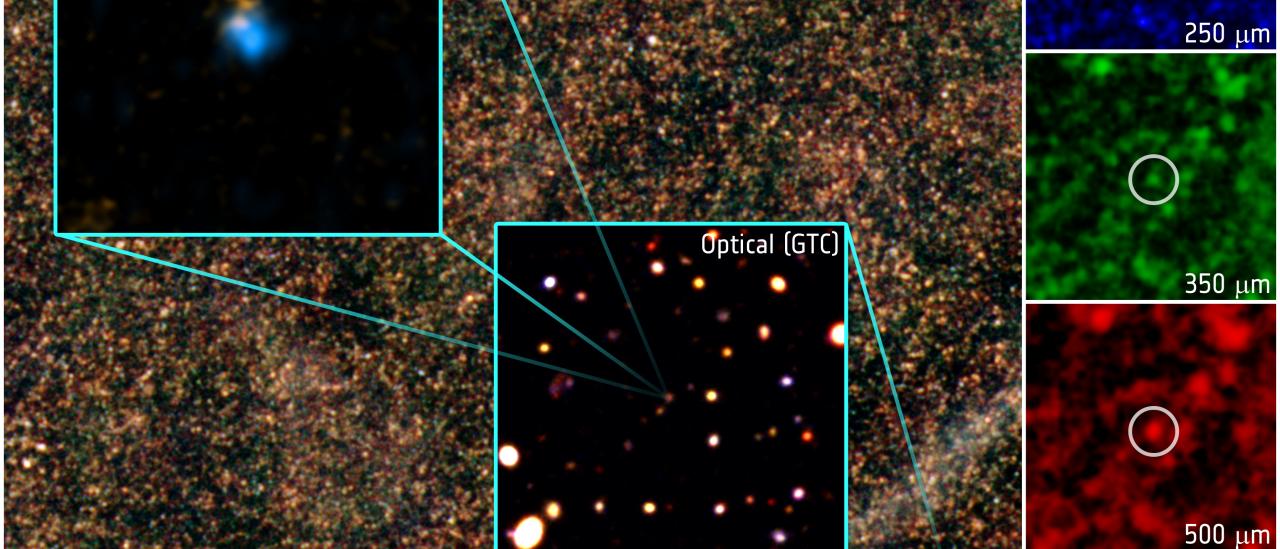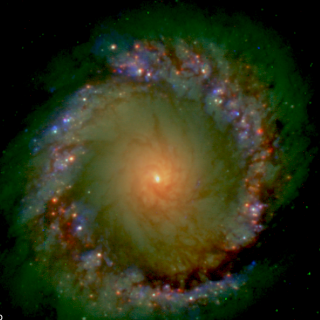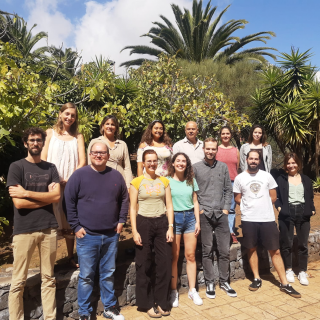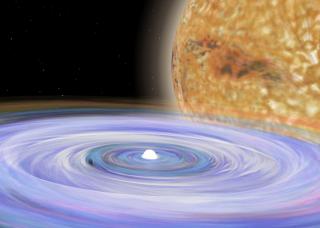Subvenciones relacionadas:
General
Este grupo desarrolla varios proyectos extragalácticos en diferentes rangos del espectro electromagnético utilizando satélites y telescopios en tierra para estudiar la evolución cosmológica de las galaxias y el origen de la actividad nuclear en galaxias activas. En el aspecto instrumental, el grupo forma parte del consorcio internacional que ha construido el instrumento SPIRE del Observatorio Espacial Herschel y del consorcio europeo que desarrolla el instrumento SAFARI para el telescopio espacial infrarrojo SPICA de las agencias espaciales ESA y JAXA.
Los proyectos principales en 2018 han sido:
a) Galaxias y cuásares distantes con emisión en el infrarrojo lejano descubiertas con el Observatorio Espacial Herschel en los "Key Projects" HerMES y Herschel-ATLAS.
b) Sloan Digital Sky Survey IV: galaxias del proyecto BELLS GALLERY y galaxias Lyman alpha muy luminosas
c) Participación en el desarrollo del instrumento SAFARI, una de las contribuciones europeas al telescopio espacial infrarrojo SPICA.
d) Descubrimiento de la estrella individual más distante conocida, en uno de los campos del proyecto "HST Frontier Fields"
e) Búsqueda de supernovas en galaxias distantes amplificadas por lentes gravitacionales.
f) Varios estudios con GTC de sistemas de absorción en la línea de visión a cuásares rojos.
Miembros
Resultados
- Marques-Chaves et al. (2018) presentan un estudio detallado de la galaxia submm HLock01 a z = 2.9574, una de las fuentes más brillantes magnificadas por una lente gravitacional descubiertas en el "Herschel Multi-tiered Extragalactic Survey".
- Rigopoulou et al. (2018) derivan la metalicidad de la fase gaseosa de la galaxia submm HLSW-01 utilizando observaciones espectroscópicas de líneas de estructura fina con Herschel. Encuentran que la metalicidad de galaxias submm luminosas es de tipo solar y que siguen la relación masa-metalicidad esperada para galaxias a z ∼ 3.
- Cornachione et al. (2018) presentan un estudio morfológico de 17 galaxias emisoras Lyman alpha magnificadas por lentes gravitacionales de la muestra BELLS GALLERY. El análisis combina el efecto de magnificación de las lentes fuertes galaxia-galaxia con la alta resolución angular del telescopio espacial Hubble para conseguir una resolución espacial de ~80 pc.
- Oteo et al. (2018) reportan la identificación de un protocúmulo de galaxias extremo en el universo temprano cuyo núcleo (denominado Núcleo Rojo Distante por su color muy rojo en las bandas de Herschel SPIRE) está formado por al menos 10 galaxias polvorientas con formación estelar, confirmadas espectroscópicamente a z = 4.002 con ALMA y ATCA.
- Kelly et al. (2018) reportan el descubrimiento de una estrella individual, Icarus, a un desplazamiento al rojo de 1.49, magnificada más de 2000 veces por el efecto de lente gravitacional del cúmulo de galaxias MACS J1149+222. Icarus está localizada en una galaxia espiral muy alejada de la tierra, su luz ha tardado 9000 millones de años en llegar a la tierra.
Actividad científica
Publicaciones relacionadas
-
The evolution of early-type galaxies in clusters from z˜ 0.8 to z ˜ 0: the ellipticity distribution and the morphological mixWe present the ellipticity distribution and its evolution for early-type galaxies in clusters from z˜ 0.8 to the current epoch, based on the WIde-field Nearby Galaxy-cluster Survey (0.04 ≤z≤ 0.07) and the ESO Distant Cluster Survey (0.4 ≤z≤ 0.8). We first investigate a mass-limited sample and we find that above a fixed mass limit (M*≥ 1010.2 M&sunVulcani, Benedetta et al.
Fecha de publicación:
52011 -
The Detection of a Population of Submillimeter-Bright, Strongly Lensed GalaxiesGravitational lensing is a powerful astrophysical and cosmological probe and is particularly valuable at submillimeter wavelengths for the study of the statistical and individual properties of dusty star-forming galaxies. However, the identification of gravitational lenses is often time-intensive, involving the sifting of large volumes of imagingNegrello, Mattia et al.
Fecha de publicación:
112010 -
Spitzer Imaging of Herschel-atlas Gravitationally Lensed Submillimeter SourcesWe present physical properties of two submillimeter selected gravitationally lensed sources, identified in the Herschel Astrophysical Terahertz Large Area Survey. These submillimeter galaxies (SMGs) have flux densities >100 mJy at 500 μm, but are not visible in existing optical imaging. We fit light profiles to each component of the lensing systemsHopwood, R. et al.
Fecha de publicación:
22011 -
On the Connection Between Shape and Stellar Population in Early-type GalaxiesWe report on the discovery of a relation between the stellar mass M* of early-type galaxies (hereafter ETGs), their shape, as parameterized by the Sersic index n, and their stellar mass-to-light ratio M*/L. In a three-dimensional log space defined by these variables, the ETGs populate a plane surface with small scatter. This relation tells us thatD'Onofrio, M. et al.
Fecha de publicación:
12011 -
Herschel-ATLAS: statistical properties of Galactic cirrus in the GAMA-9 Hour Science Demonstration Phase FieldWe study the spectral energy distribution (SED) and the power spectrum of Galactic cirrus emission observed in the 14 deg2 Science Demonstration Phase field of the Herschel-ATLAS using Herschel and IRAS data from 100 to 500 μm. We compare the Spectral and Photometric Imaging Receiver (SPIRE) 250, 350 and 500 μm maps with IRAS 100-μm emissionBracco, A. et al.
Fecha de publicación:
42011 -
Green Bank Telescope Zpectrometer CO(1-0) Observations of the Strongly Lensed Submillimeter Galaxies from the Herschel ATLASThe Herschel Astrophysical Terahertz Large Area Survey (H-ATLAS) has uncovered a population of strongly lensed submillimeter galaxies (SMGs). The Zpectrometer instrument on the Green Bank Telescope (GBT) was used to measure the redshifts and constrain the masses of the cold molecular gas reservoirs for two candidate high-redshift lensed sources. WeFrayer, D. T. et al.
Fecha de publicación:
12011 -
GAMA/H-ATLAS: the ultraviolet spectral slope and obscuration in galaxiesWe use multiwavelength data from the Galaxy And Mass Assembly (GAMA) and Herschel-ATLAS (H-ATLAS) surveys to compare the relationship between various dust obscuration measures in galaxies. We explore the connections between the ultraviolet (UV) spectral slope, β, the Balmer decrement and the far-infrared (FIR) to 150 nm far-ultraviolet (FUV)Wijesinghe, D. B. et al.
Fecha de publicación:
82011 -
Galaxy stellar mass functions of different morphological types in clusters, and their evolution between z= 0.8 and 0We present the galaxy stellar mass function and its evolution in clusters from z˜ 0.8 to the current epoch, based on the WIde-field Nearby Galaxy-cluster Survey (WINGS) (0.04 ≤z≤ 0.07), and the ESO Distant Cluster Survey (EDisCS) (0.4 ≤z≤ 0.8). We investigate the total mass function and find that it evolves noticeably with redshift. The shape at M*Vulcani, Benedetta et al.
Fecha de publicación:
32011 -
The Herschel-SPIRE instrument and its in-flight performanceThe Spectral and Photometric Imaging REceiver (SPIRE), is the Herschel Space Observatory`s submillimetre camera and spectrometer. It contains a three-band imaging photometer operating at 250, 350 and 500 μm, and an imaging Fourier-transform spectrometer (FTS) which covers simultaneously its whole operating range of 194-671 μm (447-1550 GHz). TheGriffin, M. J. et al.
Fecha de publicación:
72010 -
The Herschel Reference SurveyThe Herschel Reference Survey is a Herschel guaranteed time key project and will be a benchmark study of dust in the nearby universe. The survey will complement a number of other Herschel key projects including large cosmological surveys that trace dust in the distant universe. We will use Herschel to produce images of a statistically-completeBoselli, A. et al.
Fecha de publicación:
32010 -
The HerMES SPIRE submillimeter local luminosity functionLocal luminosity functions are fundamental benchmarks for high-redshift galaxy formation and evolution studies as well as for models describing these processes. Determining the local luminosity function in the submillimeter range can help to better constrain in particular the bolometric luminosity density in the local Universe, and Herschel offersVaccari, M. et al.
Fecha de publicación:
72010 -
Resolved Dust Emission in a Quasar at z = 3.65We present submillimeter observations of the z= 3.653 quasar SDSS 160705+533558 together with data in the optical and infrared. The object is unusually bright in the far-IR and submillimeter with an IR luminosity of ~1014 L sun. We ascribe this luminosity to a combination of active galactic nucleus (AGN) and starburst emission, with the starburstClements, D. L. et al.
Fecha de publicación:
62009 -
Properties of dusty tori in active galactic nuclei - I. The case of SWIRE/SDSS quasarsWe derive the properties of dusty tori in active galactic nuclei from the comparison of observed spectral energy distributions (SEDs) of SDSS quasars and a precomputed grid of torus models. The observed SEDs comprise SDSS photometry, Two-Micron All-Sky Survey J, H and K data, whenever available, and mid-infrared (mid-IR) data from the Spitzer WideHatziminaoglou, E. et al.
Fecha de publicación:
52008 -
Probing the molecular interstellar medium of M82 with Herschel-SPIRE spectroscopyWe present the observations of the starburst galaxy M82 taken with the Herschel SPIRE Fourier-transform spectrometer. The spectrum (194-671 μm) shows a prominent CO rotational ladder from J = 4-3 to 13-12 emitted by the central region of M82. The fundamental properties of the gas are well constrained by the high J lines observed for the first timePanuzzo, P. et al.
Fecha de publicación:
72010 -
Photometric redshifts in the SWIRE SurveyWe present the SWIRE Photometric Redshift Catalogue 1025119 redshifts of unprecedented reliability and of accuracy comparable with or better than previous work. Our methodology is based on fixed galaxy and quasi-stellar object templates applied to data at 0.36-4.5 μm, and on a set of four infrared emission templates fitted to infrared excess dataRowan-Robinson, Michael et al.
Fecha de publicación:
52008 -
Mid-infrared spectroscopy of infrared-luminous galaxies at z ~ 0.5-3We present results on low-resolution mid-infrared (MIR) spectra of 70 IR-luminous galaxies obtained with the infrared spectrograph (IRS) onboard Spitzer. We selected sources from the European Large Area Infrared Survey with S15 > 0.8 mJy and photometric or spectroscopic z > 1. About half of the samples are quasi-stellar objects (QSOs) in theHernán-Caballero, A. et al.
Fecha de publicación:
52009 -
MAMBO 1.2 mm Observations of Luminous Starbursts at z ~ 2 in the SWIRE FieldsWe report on-off pointed MAMBO observations at 1.2 mm of 61 Spitzer-selected star-forming galaxies from the Spitzer Wide Area Infrared Extragalactic Legacy survey (SWIRE). The sources are selected on the basis of bright 24 μm fluxes (f 24 μm > 0.4 mJy) and of stellar dominated near-infrared spectral energy distributions in order to favor z ~ 2Lonsdale, Carol J. et al.
Fecha de publicación:
22009 -
Herschel and SCUBA-2 imaging and spectroscopy of a bright, lensed submillimetre galaxy at z = 2.3We present a detailed analysis of the far-infrared (-IR) properties of the bright, lensed, z = 2.3, submillimetre-selected galaxy (SMG), SMM J2135-0102 (hereafter SMM J2135), using new observations with Herschel, SCUBA-2 and the Very Large Array (VLA). These data allow us to constrain the galaxy's spectral energy distribution (SED) and show that itIvison, R. J. et al.
Fecha de publicación:
72010 -
HerMES: The submillimeter spectral energy distributions of Herschel/SPIRE-detected galaxiesWe present colours of sources detected with the Herschel/SPIRE instrument in deep extragalactic surveys of the Lockman Hole, Spitzer-FLS, and GOODS-N fields in three photometric bands at 250, 350 and 500 μm. We compare these with expectations from the literature and discuss associated uncertainties and biases in the SPIRE data. We identify a 500 μmSchulz, B. et al.
Fecha de publicación:
72010 -
HerMES: The SPIRE confusion limitWe report on the sensitivity of SPIRE photometers on the Herschel Space Observatory. Specifically, we measure the confusion noise from observations taken during the science demonstration phase of the Herschel Multi-tiered Extragalactic Survey. Confusion noise is defined to be the spatial variation of the sky intensity in the limit of infiniteNguyen, H. T. et al.
Fecha de publicación:
72010



